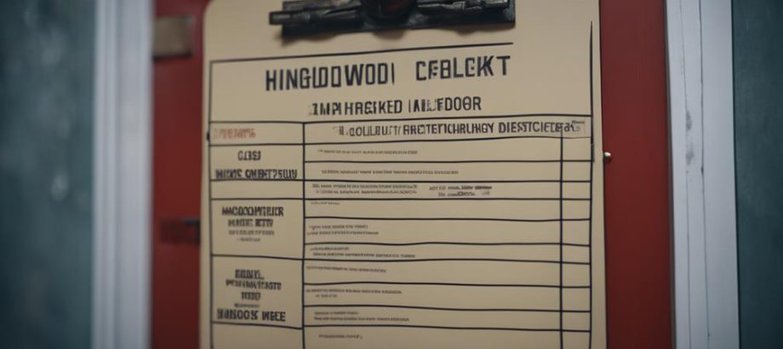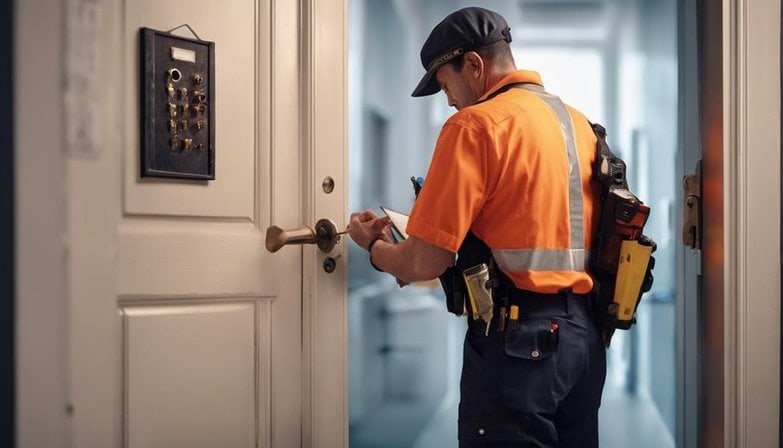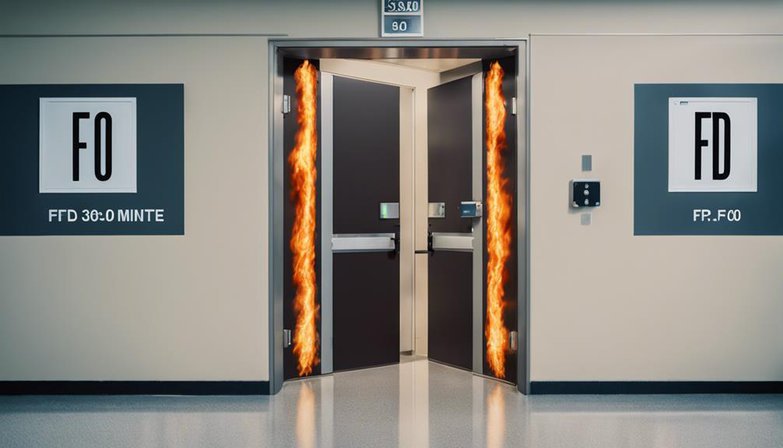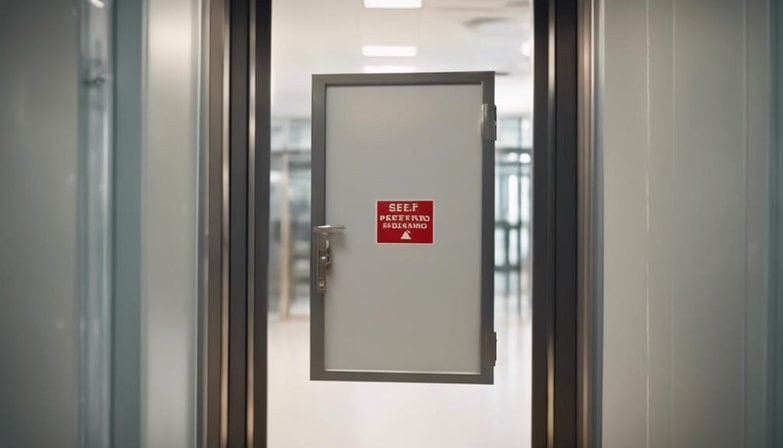Fire Door Inspection Checklist United States

To conduct a fire door inspection in the U.S., follow these steps:
- Examine for visible damage.
- Check the fire rating label.
- Ensure all components function correctly.
- Verify that the door closes and latches securely.
If any part of the checklist fails, immediate repair or replacement is necessary to meet safety and compliance standards.
Key Takeaways
- Verify fire resistance certification label is present and legible.
- Inspect door and frame for any visible damage or security issues.
- Ensure all components, including hinges and hardware, are intact and functioning.
- Check that the door closes and latches securely without obstruction.
- Confirm gaps around door edges do not exceed allowable limits and seals are intact.
What is the NFPA checklist for fire door inspection?
The NFPA checklist for fire door inspection outlines specific criteria to verify that fire doors function properly and safely in the event of a fire. As you begin your inspection, you’ll need to follow the National Fire Protection Association’s (NFPA) guidelines to ensure thoroughness and compliance.
The checklist is designed to help you identify any potential issues that might compromise the door’s ability to contain fire and smoke.
First, make certain the door and frame are free of any visible damage, such as dents, holes, or warping. Check that the door label is present and legible, indicating that it meets the necessary fire rating requirements.
Next, confirm that all components, including hinges, latches, and seals, are intact and functioning correctly. The door should close and latch securely without any obstructions.
Additionally, verify that the gaps around the door edges are within the allowed limits specified by the NFPA. Look for any missing or damaged gaskets and edge seals, as these are essential for preventing the spread of smoke.
Lastly, ensure that any hardware, such as fire exit devices, complies with NFPA standards and is in good working order.
What do you look for in a fire door inspection?
When examining a fire door, check for any visible damage or wear that could compromise its effectiveness. Start by looking at the door’s surface for any cracks, dents, or warping. These issues can impact the door’s ability to contain fire and smoke.
Next, inspect the door frame and make sure it’s securely fastened and free from damage.
Pay close attention to the following aspects:
- Door Gaps: Confirm the gaps around the door are within the allowable limits, typically 1/8 inch for the top and sides.
- Seals and Gaskets: Check that all seals and gaskets are intact and not worn down or missing. They play an essential role in preventing smoke from passing through.
- Hinges and Hardware: Verify that all hinges and hardware are secure and functioning properly. Loose or missing screws can impact the door’s performance.
- Labeling: Validate that the door’s fire rating label is present and legible. This label provides vital information about the door’s fire-resistance capabilities.
What is the FD30 fire door inspection?

An FD30 fire door inspection verifies that the door can withstand fire for at least 30 minutes, protecting lives and property during an emergency. When you perform this inspection, you need to pay attention to several critical elements to confirm the door meets safety standards. Here’s a concise guide to help you through the process.
First, check the door’s certification label, usually found on the door’s edge. This label confirms that the door has been tested and meets the FD30 standard. Next, examine the door frame and verify it is made of appropriate fire-resistant material, fitting tightly around the door without gaps.
Here’s a quick reference table for your inspection:
| Inspection Point | What to Check For |
|---|---|
| Certification Label | Presence and clarity |
| Door Frame | Material and fit |
| Intumescent Strips | Proper installation and condition |
Additionally, inspect the intumescent strips around the door edges. These strips expand when exposed to heat, sealing gaps and preventing fire spread. They should be properly installed and in good condition without any breaks or damages.
What’s the difference between FD30 and FD30S?
While examining FD30 fire doors, you might wonder about the distinctions between FD30 and FD30S standards. Both types of doors are designed to provide 30 minutes of fire resistance, but the ‘S’ in FD30S stands for smoke. This means that FD30S doors have additional features to prevent the passage of smoke, which can be just as risky as fire.
Here are the key differences between FD30 and FD30S:
- Smoke Seals: FD30S doors come equipped with intumescent strips and cold smoke seals that expand when exposed to heat, blocking smoke from passing through gaps.
- Testing Standards: FD30S doors undergo more rigorous testing to make sure they effectively prevent smoke infiltration in addition to fire resistance.
- Usage Areas: FD30S doors are often required in areas where smoke control is essential, such as escape routes and places with high occupancy.
- Cost: FD30S doors generally cost more due to the added smoke-sealing features and testing requirements.
Understanding these differences helps you choose the right door for your specific needs and comply with safety regulations. Always check the manufacturer’s specifications and local building codes to make informed decisions.
Do I need FD30 or FD60 fire doors?

Choosing between FD30 and FD60 fire doors depends on the specific fire safety requirements of your building and local regulations. FD30 fire doors provide 30 minutes of fire resistance, while FD60 fire doors offer 60 minutes. You need to evaluate the building’s occupancy, purpose, and fire risk before making a decision.
For residential buildings, FD30 doors are often sufficient, especially if the property is smaller or has fewer occupants. However, for commercial buildings, high-rise apartments, or areas with higher fire risks, FD60 doors might be necessary. Always refer to local building codes and fire safety guidelines to ensure adherence.
Here’s a quick comparison to help you decide:
| Criteria | FD30 Fire Doors | FD60 Fire Doors |
|---|---|---|
| Fire Resistance Duration | 30 minutes | 60 minutes |
| Typical Use Cases | Residential, low-risk | Commercial, high-risk |
| Installation Cost | Lower | Higher |
| Compliance with Building Codes | Check local regulations | Check local regulations |
Before you proceed, review your building’s fire safety plan and consult with a fire safety expert. Ensuring you have the appropriate fire door can have a significant impact on the safety and legal compliance of your building. Don’t forget to verify the integrity and certifications of the doors you choose.
Do all fire doors need to be certified?
All fire doors must be certified to guarantee they meet the necessary safety standards and provide the required level of fire resistance. Certification validates that the fire doors have been tested and can perform effectively in the event of a fire. Without certification, there’s no assurance that the doors will hold up under fire conditions, putting lives and property at risk.
When looking for certified fire doors, confirm they meet the following criteria:
- Fire Resistance Ratings: Verify that the door has the correct rating (e.g., FD30, FD60) for your specific needs.
- Labeling: Check for a certification label or mark from a recognized testing authority like Underwriters Laboratories (UL).
- Installation: Verify the door is installed according to the manufacturer’s instructions and the certification requirements.
- Maintenance: Regularly inspect and maintain the door to keep it in good working condition, as required by the certification.
Certification is crucial for compliance with building codes and safety regulations. It provides peace of mind, knowing that the fire doors you’ve installed will function correctly in an emergency. Always choose certified fire doors to protect your building and its occupants.
What are the requirements for a fire-rated door?

Knowing that certification is obligatory, you should comprehend the prerequisites a fire-rated door must meet to be efficient and compliant. Firstly, the door must have a label or certification mark from a recognized testing agency like UL or Intertek. This mark guarantees that the door has been tested to meet fire-resistance standards.
The door must be of a specific material, often steel or solid wood, and it needs to be able to withstand fire for a designated period, typically 20, 45, 60, or 90 minutes. The door frame should also be fire-rated and properly installed to uphold the integrity of the fire barrier.
Hinges and other hardware must be fire-rated as well. Self-closing mechanisms are necessary to guarantee the door closes automatically after being opened. The door should fit well within its frame, with minimal gaps, generally less than 1/8 inch along the edges.
Intumescent seals, which expand when exposed to heat, should be installed to prevent smoke and flames from passing through gaps. Lastly, any glass components need to be fire-rated and installed according to code.
Meeting these prerequisites will secure your fire-rated door is both compliant and efficient.
How to Pass Door Inspection?
To pass a door inspection, make certain every component of your fire-rated door meets the necessary standards and functions correctly. Start by checking the door label to confirm it’s certified for fire resistance. Inspect the frame for damage, and verify it’s securely fastened to the wall with no gaps wider than 1/8 inch.
Next, examine the door hardware. Confirm all hinges, locks, and handles are fire-rated and properly installed. The door should close automatically and latch securely without assistance. Validate the door closer is working correctly and isn’t leaking fluid.
Remember to check these key points:
- Gaskets and seals: Ensure that all gaskets and seals are intact, properly installed, and not worn out.
- Door clearance: Make certain the clearance under the door doesn’t exceed 3/4 inch, and the gap around the door is consistent.
- Intumescent strips: Verify the intumescent strips are present and properly adhered to the door or frame.
- Glass and glazing: If the door has glass, confirm it’s fire-rated glass, and the glazing has no cracks or damage.
Final Steps
To guarantee fire safety and compliance, follow the NFPA checklist for fire door inspections. Check for visible damage, confirm the fire rating label is present and legible, and make certain all components function properly.
Verify the door closes and latches securely, and inspect the gaps around the edges. Regular inspections and adherence to guidelines will help maintain the integrity of your fire doors and contribute to building safety.
